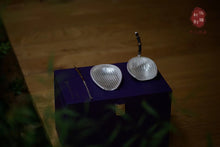
In the process of brewing tea and making soup, the fewer "checkpoints" are passed through, the less the taste of the tea soup will be affected. In addition, for some tea types, if you don’t go through the tea drain, you may have an imperfect experience.
Today, Tongxinshe Teahouse has teamed up with Mr. Hong Jike to bring you exquisite handmade tea drains, tea bags and tea needle sets from the century-old pot-making family "Hong Kee Treasures".
——· Silver wire dustpan and silver tea drain ·——
• Dimensions: Width 12 X 8 cm
• Weight: 38g
• Material: Sterling Silver 999.9
• Craftsmanship: Purely handmade
——· Silver wire dustpan and silver tea rule ·——
• Dimensions: Length 10.5 x Width 7.5cm
• Weight: 43g
• Material: Sterling Silver 999.9
• Craftsmanship: Purely handmade
Purple bamboo branch sterling silver tea dial, with silver as the dial, bamboo as the handle, elegance as the meaning, traditional craftsmanship, mortise and tenon structure, sterling silver handmade, horn as decoration, simple and natural, light touch.
In the "Tea Classic" written by Lu Yu, the tea drain is called a water filter bag, which is a water filtering tool used to remove foreign matter in tea. In the old days, the material mostly used was raw copper. After all, wrought copper and iron are extremely easy to adhere to dirt or rust, affecting the taste of the soup. Nowadays, stainless steel and some bamboo are often used as the framework, which has a significant impact on the taste of the soup. It will not only weaken the original aroma and sweetness, but even directly tamper with the texture of the soup. This is really unforgivable for tea lovers. Sin, in this regard, the birth of the sterling silver tea drain is an "invention" that coordinates with each other and promotes each other. The sterling silver material allows the tea to flow through it without changing the taste experience. At the same time, unnecessary tea leaves are filtered out, maximizing the pleasure of drinking tea.
The dustpan-like shovel-shaped instrument is still deeply loved by the working people. It can not only carry food, but also remove debris. It is a must-have in the daily life of farmers. The dustpan has a narrow mouth and a deep nest. In folk culture, it means that it can hold more food and wealth.
Dustpans are generally made of bamboo silk. This sterling silver tea drain follows the traditional weaving technique of dustpans and is made of silver wire. The exquisite technique demonstrates the wisdom of Chinese working people and the ingenuity of modern craftsmen. Naturally The silver wire gap is just enough for tea to leak out. It is a work of wisdom. The dustpan has a handle, which is convenient to hold. The shovel shape with a closed mouth can also be used as a small tea bag. It has multiple uses. It is very interesting and worth buying!
From a piece of silver plate to such exquisite silverware, dozens of processes such as silver melting, forging, drawing, inlaying, welding, ligation, twisting, spelling, and trimming are required. The texture of craftsmanship is the highest expression of the craftsman’s patience.
The "Hongji Treasure" in Heqing, Yunnan began during the Guangxu period of the Qing Dynasty and has been passed down for five generations. They still insist on using traditional pot-making techniques. As the fourth generation descendant of "Hong Kee Treasures", Mr. Hong Jike is proficient in a variety of handmade pot making techniques.
Hong Jike, Bai ethnic group, was born in 1971. The fourth generation successor of "Hong Kee Treasure". The ninth batch of intangible cultural heritage projects in Heqing County, the representative inheritor of silver jewelry forging technology (Heqing silver forging technology).
His ancestors have been silversmiths for five generations. Since childhood, he has learned the traditional craftsmanship of gold, silver and copper crafts from his father. In 1988, he was able to independently complete the production of metal crafts. In 2005, he went to Tibetan areas to engage in the production of Tibetan Buddhist supplies. During this period, he designed and produced the "Gilded Buddha Statue". In 2007, he returned to his hometown and started making handmade silver pots and sterling silver tea sets. After more than thirty years of hard work, he has frequently produced excellent works. His works have been collected many times, and his creative styles are diversified, profound and original.




















































